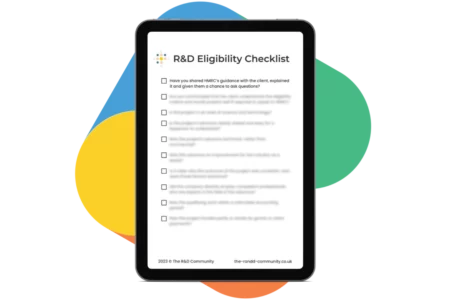Businesses often state that “there’s no existing technology that can match this solution.” However, they often don’t present the evidence to back up their statement in the way that HMRC requires.
Why is a technological baseline so important?
HMRC says that to qualify for relief, projects need to actively seek an advance in science or technology by resolving technological uncertainties. In order to show that an advance was made, you need something to compare it to. That’s where the technological baseline comes into play.
As HMRC continues to scrutinise R&D claims and the companies submitting them, clarity is crucial. In practice, the baseline is the backbone of a claim, and the entire claim can hinge on its strength.
Technological baselines in practice
Let’s take a look at an example.
A company thinks that it qualifies for R&D tax relief because it meets the requirements of CIRD 81910 Paragraph 9c. This allows businesses to claim R&D tax relief based on making appreciable improvements to an existing process, material, device, or service through scientific or technological changes. Let’s say they’ve created a more efficient device for a specific task compared to existing devices.
First, they have to pinpoint the field in which the advance has been made, so that they can outline what was already possible. Was it through an advance in hydraulic engineering which surpassed known solutions? Or, it could be an advance in mechanical engineering as the structure of the device was re-engineered to provide greater capability. Maybe the improved capability was a result of development in material engineering that was incorporated into an existing design?
Next, they should describe what was already possible in that field and the reasons why available techniques, tools and solutions weren’t capable of solving their problem.
Simply stating that a product is better than anything else currently available isn‘t sufficient. You need to be as specific and detailed as you can, describing existing solutions and explaining their limitations. This lays a solid foundation for an R&D project and demonstrates that a thorough assessment of the field has been made.
Finally, the credibility of this baseline rests on the qualifications and experience of the Competent Professional, so you also have to make sure to present them clearly.
If the technological baseline is poorly defined, HMRC might argue that the work is bespoke to the company and doesn’t represent an overall advance for the industry.
How a technological baseline supports an R&D narrative
Now that HMRC is running a much tighter ship, it is issuing compliance checks at a higher rate than ever before. That’s why it’s so important to get the fundamental things right in every claim.
By presenting a clear technological baseline, you make it much easier for HMRC to understand the advance sought in the project. It’s the point of reference that helps HMRC decide whether the work constitutes an advance and whether it’s significant enough to qualify.
With HMRC being so picky these days, there’s no doubt that writing an effective R&D narrative can be a tricky process. To ease your transition into this new era of scrutiny, take a look at our article, A Beginner’s Guide to Claiming R&D Tax Relief. Whether you’re a beginner or not, it covers the core elements integral to a strong R&D claim, and can help you spot areas for improvement within your claim preparation processes.
If you want to go even more in depth, our course, Establishing Eligibility, is a comprehensive resource on building strong claims from the ground up. You can now purchase this directly from our website and start learning right away!





